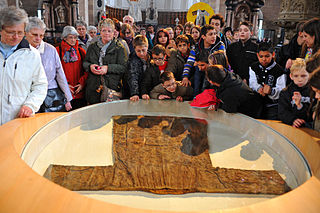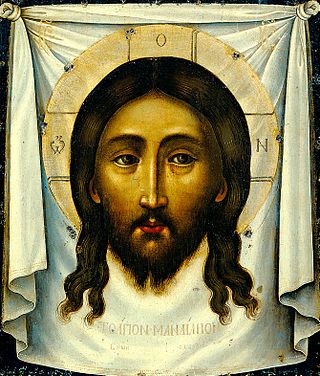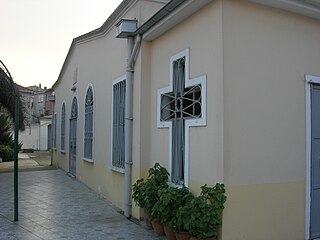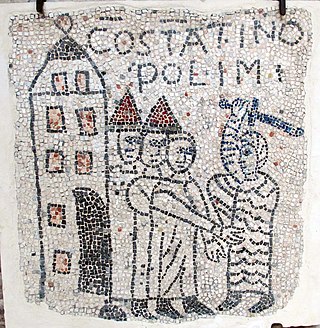
Constantinople became the capital of the Roman Empire during the reign of Constantine the Great in 330. Following the collapse of the Western Roman Empire in the late 5th century, Constantinople remained the capital of the Eastern Roman Empire, the Latin Empire (1204–1261), and the Ottoman Empire (1453–1922). Following the Turkish War of Independence, the Turkish capital then moved to Ankara. Officially renamed Istanbul in the 1920s, the city is today the largest city and financial centre of Turkey and the largest city in Europe, straddling the Bosporus strait, lying in both Europe and Asia.

Hagia Sophia, officially the Hagia Sophia Grand Mosque, is a mosque and a major cultural and historical site in Istanbul, Turkey. The last of three church buildings to be successively erected on the site by the Eastern Roman Empire, it was completed in 537 AD. The site was an Eastern Orthodox church from 360 AD to 1204, when it was converted to a Catholic church following the Fourth Crusade. It was reclaimed in 1261 and remained Eastern Orthodox until the Ottoman conquest of Constantinople in 1453. It served as a mosque until 1935, when it became a museum. In 2020, the site once again became a mosque.
This is an alphabetical index of people, places, things, and concepts related to or originating from the Byzantine Empire. Feel free to add more, and create missing pages. You can track changes to the articles included in this list from here.
A number of alleged relics associated with Jesus have been displayed throughout the history of Christianity. While some individuals believe in the authenticity of Jesus relics, others doubt their validity. For instance, the sixteenth-century philosopher Erasmus wrote about the proliferation of relics, and the number of buildings that could be constructed from wooden relics claimed to be from the crucifixion cross of Jesus. Similarly, at least thirty Holy Nails were venerated as relics across Europe in the early 20th century. Part of the relics are included in the so-called Arma Christi, or the Instruments of the Passion.

The Seamless Robe of Jesus is the robe said to have been worn by Jesus during or shortly before his crucifixion. Competing traditions claim that the robe has been preserved to the present day. One tradition places it in the Cathedral of Trier, another places it in Argenteuil's Basilique Saint-Denys, and several traditions claim that it is now in various Eastern Orthodox churches, notably Svetitskhoveli Cathedral in Mtskheta, Georgia.

Byzantine dress changed considerably over the thousand years of the Empire, but was essentially conservative. Popularly, Byzantine dress remained attached to its classical Greek roots with most changes and different styles being evidenced in the upper strata of Byzantine society always with a touch of the Hellenic environment. The Byzantines liked colour and pattern, and made and exported very richly patterned cloth, especially Byzantine silk, woven and embroidered for the upper classes, and resist-dyed and printed for the lower. A different border or trimming round the edges was very common, and many single stripes down the body or around the upper arm are seen, often denoting class or rank. Taste for the middle and upper classes followed the latest fashions at the Imperial Court.

The siege of Constantinople of 860 was the only major military expedition of the Rus' Khaganate recorded in Byzantine and Western European sources. The casus belli was the construction of the fortress Sarkel by Byzantine engineers, restricting the Rus' trade route along the Don River in favor of the Khazars. Accounts vary, with discrepancies between contemporary and later sources, and the outcome is unknown in detail.

Acheiropoieta — also called icons made without hands — are Christian icons which are said to have come into existence miraculously; not created by a human. Invariably these are images of Jesus or the Virgin Mary. The most notable examples that are credited by tradition among the faithful are, in the Eastern church, the Mandylion, also known as the Image of Edessa, and the Hodegetria, and several Russian icons, and in the West the Shroud of Turin, Veil of Veronica, Our Lady of Guadalupe, and the Manoppello Image. The term is also used of icons that are only regarded as normal human copies of a miraculously created original archetype.
The bliaut or bliaud is an overgarment that was worn by both sexes from the eleventh to the thirteenth century in Western Europe, featuring voluminous skirts and horizontal puckering or pleating across a snugly fitted under bust abdomen. The sleeves are the most immediately notable difference when comparing the bliaut to other female outer clothing of the Middle Ages. They fit closely from the shoulder to approximately the elbow, and then widen from the elbow to drape to floor- or nearly floor-length. This garment's usage appears to be geographically limited to areas of French influence, with some works depicting the garment or the garment in transition as far away as Rome and modern Germany.

Twelfth century European fashion was simple in cut and differed only in details from the clothing of the preceding centuries, starting to become tighter and more similar for men and women as the century went on, which would continue in the 13th century. Men wore knee-length tunics for most activities, and men of the upper classes wore long tunics, with hose and mantle or cloaks. Women wore long tunics or gowns. A close fit to the body, full skirts, and long flaring sleeves were characteristic of upper-class fashion for both men and women.

The siege of Constantinople in 626 by the Sassanid Persians and Avars, aided by large numbers of allied Slavs and Bulgars ended in a strategic victory for the Byzantines. The failure of the siege saved the empire from collapse, and, combined with other victories achieved by Emperor Heraclius the previous year and in 627, enabled Byzantium to regain its territories and end the destructive Roman–Persian Wars by enforcing a treaty with borders status quo c. 590.

The Church of Saint Mary of Blachernae is an Eastern Orthodox church in Mustafa Paşa Bostanı Sokak in Ayvansaray in the Fatih district of Istanbul, just inside the old walled city. During the latter part of the Byzantine period, the original church complex on the site was one of the most important sanctuaries of Byzantium, arguably outstripping Hagia Sophia in importance due to its proximity to the Palace of the Blachernae. The Byzantine church complex was destroyed in 1434, and in the nineteenth century a small new church was built on the site. Today it is protected by a high wall, and fronted by a garden.

The sack of Constantinople occurred in April 1204 and marked the culmination of the Fourth Crusade. Crusader armies captured, looted, and destroyed parts of Constantinople, then the capital of the Byzantine Empire. After the capture of the city, the Latin Empire was established and Baldwin of Flanders was crowned Emperor Baldwin I of Constantinople in the Hagia Sophia.
Bonus was a Byzantine statesman and general, one of the closest associates of Emperor Heraclius, who played a leading role in the successful defense of the imperial capital, Constantinople, during the Avar–Persian siege of 626.

The Cincture of the Theotokos is believed to be a relic of the Theotokos, now in the Vatopedi monastery on Mount Athos, which is venerated by the Holy Eastern Orthodox Church. The word "cincture" is sometimes also translated as "belt", "sash" or "girdle". It is the Orthodox equivalent of the Girdle of Thomas in the Western church, and the Syriac Holy Girdle. Its feast day is September 13.

The Girdle of Thomas, Virgin's Girdle, Holy Belt, or Sacra Cintola in modern Italian, is a Christian relic in the form of a "girdle" or knotted textile cord used as a belt, that according to a medieval legend was dropped by the Virgin Mary from the sky to Saint Thomas the Apostle at or around the time of the Assumption of Mary to Heaven. The supposed original girdle is a relic belonging to Prato Cathedral in Tuscany, Italy and its veneration has been regarded as especially helpful for pregnant women. The story was frequently depicted in the art of Florence and the whole of Tuscany, and the keeping and display of the relic at Prato generated commissions for several important artists of the early Italian Renaissance. The Prato relic has outlasted several rivals in Catholic hands, and is the Catholic equivalent of the various relics held by Eastern Christianity: the Cincture of the Theotokos of the Eastern Orthodox Church and the Holy Girdle of the Syriac Orthodox Church.

The Panagia Agiosoritissa or Hagiosoritissa is the name for a type of Marian icon, showing Mary without child, slightly from the side with both hands raised in prayer. The type is known in Latin as Maria Advocata.

The Avar–Byzantine wars were a series of conflicts between the Byzantine Empire and the Avar Khaganate. The conflicts were initiated in 568, after the Avars arrived in Pannonia, and claimed all the former land of the Gepids and Lombards as their own. This led to an unsuccessful attempt to seize the city of Sirmium from Byzantium, which had previously retaken it from the Gepids. Most subsequent conflicts came as a result of raids by the Avars, or their subject Slavs, into the Balkan provinces of the Byzantine Empire.
Theodore Synkellos was a Byzantine clergyman, diplomat and writer who flourished in the first half of the 7th century. He wrote in Greek.
The Euthymiac History is a Chalcedonian ecclesiastical history preserved today only in fragments quoted in other works. It is notable for containing the earliest reference to the doctrine of the Assumption of Mary.
![Deposition of the Robe of the Virgin [fr] on an icon from 1485 Deposition of the Robe of Virgin Mary (XV c).jpg](http://upload.wikimedia.org/wikipedia/commons/thumb/0/09/Deposition_of_the_Robe_of_Virgin_Mary_%28XV_c%29.jpg/220px-Deposition_of_the_Robe_of_Virgin_Mary_%28XV_c%29.jpg)












